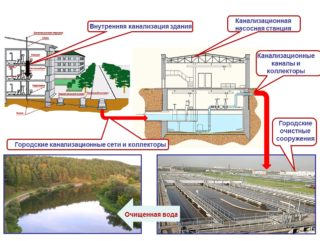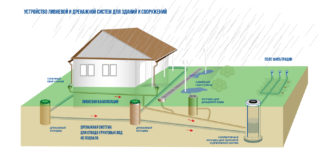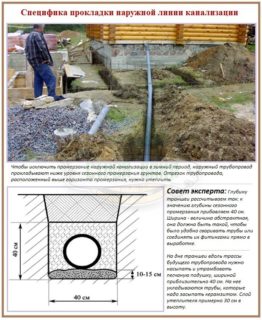To comply with sanitary and hygienic standards, it is necessary to ensure high-quality disposal of sewage from all residential and industrial facilities. For this purpose, a sewerage system is being installed. Its pipelines, as communicating vessels, are eventually found in VOCs (local treatment plants). Private sewer drains flow into a pre-assembled septic tank or cesspool.
Definition and purpose
Disruptions and malfunctions of the city sewer can lead to a serious environmental disaster.
Classification and device
The collector for drainage is divided into types according to purpose, location relative to the building and type of construction. The following systems are distinguished by the location zone:
- Internal sewerage: a network of pipelines installed inside the building. Each plumbing fixture has a branch towards the central riser. Through it, wastewater is subsequently transported to the public network.
- External sewerage: pipeline and other communication elements outside buildings, thanks to which sewage is sent to a local treatment plant. As a rule, the external collector is installed underground. The diameter of the pipes differs depending on the volume of the transported dirty water.
- Stormy. Serves to drain rainwater from buildings, roads, highways, runways.
- Drainage. Allows you to remove excess groundwater from the site.
- Fecal. Sewerage, through which household and industrial wastewater is removed.
By design, the collectors are divided into three groups:
- Separated. It implies a separate transportation of domestic, industrial and storm water and separate receivers for them.
- Semi-split. Drainage of wastewater through different lines and their further accumulation in a single reservoir.
- General alloy. Rainwater and household sewage is transported through one collector to a common treatment basin.
For household (fecal) sewage, the K1 marking is applicable; for storm water - K2; for industrial - K3. Do not confuse the city sewage mains with cable ducts. Underground collectors are also arranged for it.
Sewer system elements
For a collector in a building, the following elements are used:
- pipes;
- water locks;
- branches and tees;
- fitting;
- fecal pump (if necessary, if it is not possible to transport wastewater by gravity due to the peculiarities of the structure or relief on the site).
For outdoor sewerage use:
- Pipes made of polymer, cast iron or concrete.
- Wells (revision, overflow, storage, drainage) depending on the type, length and configuration of the collector (straight, curved). The inspection well helps in removing blockages in certain sections of the pipeline.
- Receiver, also known as septic tank, shambo, cesspool, aeration tank. Everyone chooses a reservoir for themselves according to available funds. Sometimes a septic tank is built from car tires or reinforced concrete rings.The storage device is installed with a private sewage system.
- Caisson. It is necessary if the installation of a fecal pump is provided for in the collector section In this case, the sewage system is considered pressure.
When installing an external network, it is better to use plastic pipes in a corrugation. Here the rings play an additional role of stiffening ribs, the soil will not exert pressure on the collector.
Actual requirements

When designing and installing a collector, it is important to adhere to sanitary norms and rules (SNiP). Otherwise, the efficiency of the system will be zero.
Requirements for the location and installation of external sewerage:
- A cesspool or septic tank is located at least 5 meters from the house. From wells or wells - at a distance of 20 meters.
- The piping material must be durable and corrosion resistant.
- The depth of the collector is located below the freezing of the soil at the site. Otherwise, the pipeline is insulated with high quality.
- Bends and bends should not be mounted at a 90 degree angle. Sharp drops will lead to blockages in the manifold.
- Bias. One of the most important points when installing a sewer system. In order for the sewage to flow into the receiver by gravity, pipes must be laid at a slope towards the septic tank / pit. The smaller the lumen of the tube, the greater the slope is made. With a cross-section of 50 mm, the slope of the gravity sewer is 3 cm per 1 running meter of the collector. With a diameter of 100 mm - 2 cm / l. With a section of 160 mm and more 0.8-0.7 mm / l.m.
According to SNiP, under the sewer pipes and a septic tank, the base must be arranged. The heavier the collector, the more durable it needs to be. A concrete platform is poured under polymer barrels and aeration tanks, and a sand cushion is sufficient under the pipes.
Preparing for the installation of an external sewage system
After all the calculations, it is important to prepare the trench and pipe out of the house. To do this, a hole is formed in the foundation low (15 cm below the ground level) and a steel sleeve is necessarily inserted into it. A pipe is led out through it.
The trench is dug in accordance with the planned scheme. At the same time, a bias towards the septic tank is observed. The bottom of the trench is carefully tamped and covered with a layer of slightly wet sand. It also compresses well. If it is impossible to dig a trench for any reason (there is a building, there is a roadway, etc.), use the method of horizontal directional drilling to lay the pipeline.
Installation steps
As a rule, all tubes are joined into a bell - each end of the next element is inserted into the bell of the previous one until it stops. When it comes to the installation of plastic elements, all joints are treated with a sealant and laid with rubber seals. Cast iron pipes are boiled or caulked with a special solution.
The fully assembled system is checked for leaks and only then is it insulated, if necessary, and buried. It is important to ensure that the collector does not sag in any of the sections, otherwise, over time, this will lead to a breakdown in the communication.
It is forbidden to ram the soil over the laid pipes. Over time, he will sit down under the influence of precipitation.
Operation and maintenance
- It is forbidden to dump large personal hygiene items into the toilet. This can provoke a blockage in one of the sections of the pipeline.
- Once a year, it is advisable to flush the external collector with a strong pressure of hot water (50-60 degrees). This will help prevent siltation of the walls of the system, the growth of fatty polyps on them.
- For the winter period, if no one will use the sewage system, it is advisable to insulate all plumbing fixtures in the house, or to organize regular heating of the room. Otherwise, the system will freeze on the side of the house, which can lead to a burst of the toilet bowl and pipes. If freezing does occur, you need to wait until spring, until the collector thaws arbitrarily.
Correct operation of an autonomous sewage system extends its service life by decades.













